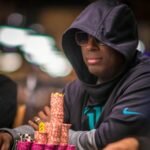Top Two vs Set Cool or weak game
This morning, a hand was held at the Main Event. The British amateur and audience favorite John Hesp ran as a chipleader in the main event of the WSOP with a top two pair in a set of the second in the counts, Scott Blumstein. Hesp lost over three quarters of his stack and gave the young American the lead. Top-Two against a set is that just bad luck or was the disaster avoidable? We would like to take a brief look at this hand, which impressively impresses the Main Event so far.
The questionable hand
Let us look at the hand quite soberly. It is the 47th hand of the final, still 8 players are in the race, everyone has 1.2 million dollars secure and John Hesp is clear chip leader. With this hand, about 44 percent of all chips were in the middle and then Scott Blumstein is a clear chip leader. John Hesps once huge stack is reduced to re-shove size.
The game before and on the flop
Preflop is not unusual in the game of both parties. The Raise Blumstein’s, his bet size, as well as the call with ace-ten in the big blind are absolute standard. On the flop meets, Blumstein top set and he decides not to put this. The flop could hardly be drier – hardly a draw is realistic at Hesp and Blumstein holds two of the three remaining aces in the hand. From his perspective, it is very unlikely that his opponent has a good hand and Blumstein is doing well to give him a card to catch up a little.
After a ten on the turn, Blumstein still holds the nuts, but now he has to start building a pot. He has to hope that his opponent has some hand that pays him as high as possible. He plays half a pot a good size to get a few chips in the middle. Blumstein does not know what kind of fireworks will come and is trying to get a bet on the turn of hands like Nine, Eighth or Ten-X on the turn and later one on the river.
For John Hesp, the ten is obviously his money card. He has just hit Top 2 and is expecting to lie in front for miles. This assumption is completely correct. His opponent finally checked the flop and played half a pot on the turn. In the overwhelming majority of cases, Hesp will be on the turn with Top-Two in the front. Hesp chooses a move, which he already several times and usually with very strong hands brought. It checks-raises almost the minimum and increases to 7,000 chips.
The amount of his bet is at least a little unorthodox, but by no means per se wrong. For this reason, he gives his opponent the opportunity to stay with weak hands in the game, and at the same time builds Hesp with his very strong hand a large pot.
Back to Scott Blumstein, who certainly is quite ecstatic about the rage of his opponent? He knows how John plays Hesp and he knows that this check-raise is a strong indicator of a good hand with the British. Sets or even aces-up are now the most likely hands in Hesps Range and against these Blumstein wants to play a maximum large pot, he has clearly dominated. He brings a 3 bet to 17,000 and thus increases by 10,000 chips.
The height of the Raise may be somewhat small. Because Blumstein gives – no matter how much he reraises to recognize that he has a monster and a higher bet size would have made it easier for him to come all-in on the river, Hesp should call. However, in principle, the remedy is little to criticize. Up to now, each player had four actions in their hands, and each of these actions was correct from the player’s point of view, or at least not wrong. Let us now come to the fatal decision of John Hesps.
However friendly the Briton John Hesp may be, so catastrophic was also this 4-Bet, which he brought there. He probably had other better options and he made a mistake about over one million dollars in equity. Before the 4-Bet on the turn are about 40,000 chips in the middle. Hesp increases by an effective 61,000 chips and brings a clear overbeat.
The biggest mistake on this 4-Bet is that there is no hand that calls this raise and is still ahead of the Hesp. With the raise, Hesp isolates himself against every better hand and persuades his opponent to discard any weaker hand that may still be present in his range. Sure, Hesp is here rather seldom behind. Aces, tines, sevens, and five-these are the only hands he loses, and there are ten possible combinations. However, with the re-run, Hesp makes sure that he either wins the pot as he is, or looks virtually hopelessly a showdown.
What could Hesp have done better?
With the 3-bet of Scott Blumstein on the turn John Hesp should ring a few alarm bells. Obviously, this is also the case, which suggests at least his jump from the chair. But the correct reaction to a possible disaster is not to press once again vigorously on the accelerator pedal. If you are running Top-Two in a top set, it is unavoidable that you lose many chips that are not at all questionable. But with an extremely tight ICM-heavy game you can limit your losses and do not have to sink 80 big blinds.
Could you fold your hand?
To demand that Hesp should have given up his hand after 3-bet, is result-oriented and out of place. He gets good pot odds and it is not entirely ruled out that Blumstein holds a hand like Ace-Seven or Ace-Five (suited) or maybe even Ace-Ten. The scenarios are not overly probable, but John Hesp has enough space to re-evaluate the situation on the river.
According to a call, some 40,000 chips are in the middle and realistic, Blumstein on the river after a check probably put between 20,000 and 40,000 chips. Here Hesp could have found a fold after the play. But even if he had not succeeded, he would have saved at least 20,000 chips.









